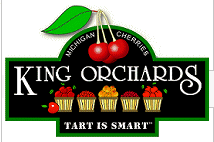home > health benefits > antioxidants
Tart Cherries and Antioxidants
Tart cherry juice scores highest in antioxidant capacity
Tart cherry juice concentrate scored highest of all fruits and vegetables in recently conducted extensive nutraceutical evaluations and ORAC testing by Brunswick Laboratories.
Tart cherry products were tested for what are called "ORAC values." ORAC stands for oxygen radical absorption capacity and is a measure of how many antioxidants are in a food product and how powerful they are. While the science-based research shows that tart cherries are loaded with antioxidants, we never had a number, or an ORAC value, to register the exact amount.
The testing showed that tart cherry juice concentrate has 12,800 ORAC units per 100 grams of concentrate; dried cherries have 6,800 ORAC units per 100 grams. Both of these are very high values, significantly higher than other fruits, including prunes, blueberries and strawberries. The ORAC value for frozen tart cherries is 2,033 units and 1,700 units for canned tart cherries. Other fruits that have been tested range from 700 to 5,700 ORAC units per 100 grams. Nutritionists suggest that people consumer at least 3,000 to 5,000 ORAC units per day to have an impact on health.
During the testing of tart cherry products, Brunswick Labs discovered for the first time that tart cherries contain a class of compounds that act like super oxide dismutase (SOD), which is a powerful enzyme and cellular antioxidant. It acts as a super scavenger of superoxide anions by ferreting out and destroying them throughout the body. The human body is often lacking SOD, thus the burden of defense often relies on intake of exogenous dietary antioxidants. Very few natural foods contain SOD.
In addition, tart cherries were found to contain significant levels of antioxidant activities against peroxyl radicals, peroxylnitrite, hydroxyl radicals (known as NORAC and HORAC).
Why antioxidants and other natural compounds are important
Antioxidants are vitamins, minerals, and other compounds found in foods that can help slow down or prevent the oxidation process. There are at least 17 compounds in tart cherries with antioxidant properties. Antioxidants help prevent or repair damage done to the body's cells by free radicals.
What you need to know about antioxidants
Based on scientific evidence, daily antioxidant intake should increase to 3,000 to 5,000 ORAC units per day to reach a significant antioxidant capacity in blood plasma and other tissues. According to the U. S. Department of Agriculture (USDA), current intake is about 1,200 units per day.
Aging and antioxidant protection
Several theories have been proposed to account for age-related changes in cell functioning and physiological capability. The free radical theory is perhaps the strongest and best-established theory scientifically to account for many age-related changes. Free radicals are molecules with one or more unpaired electrons; they seek stability by taking electrons from other molecules (a process called oxidation). As a consequence, free radicals damage the molecules from which they take electrons, leading to cell damage, impaired functioning, and even cell death. The prime molecules in the body that are damaged by free radicals are DNA, lipids, and proteins.

|





